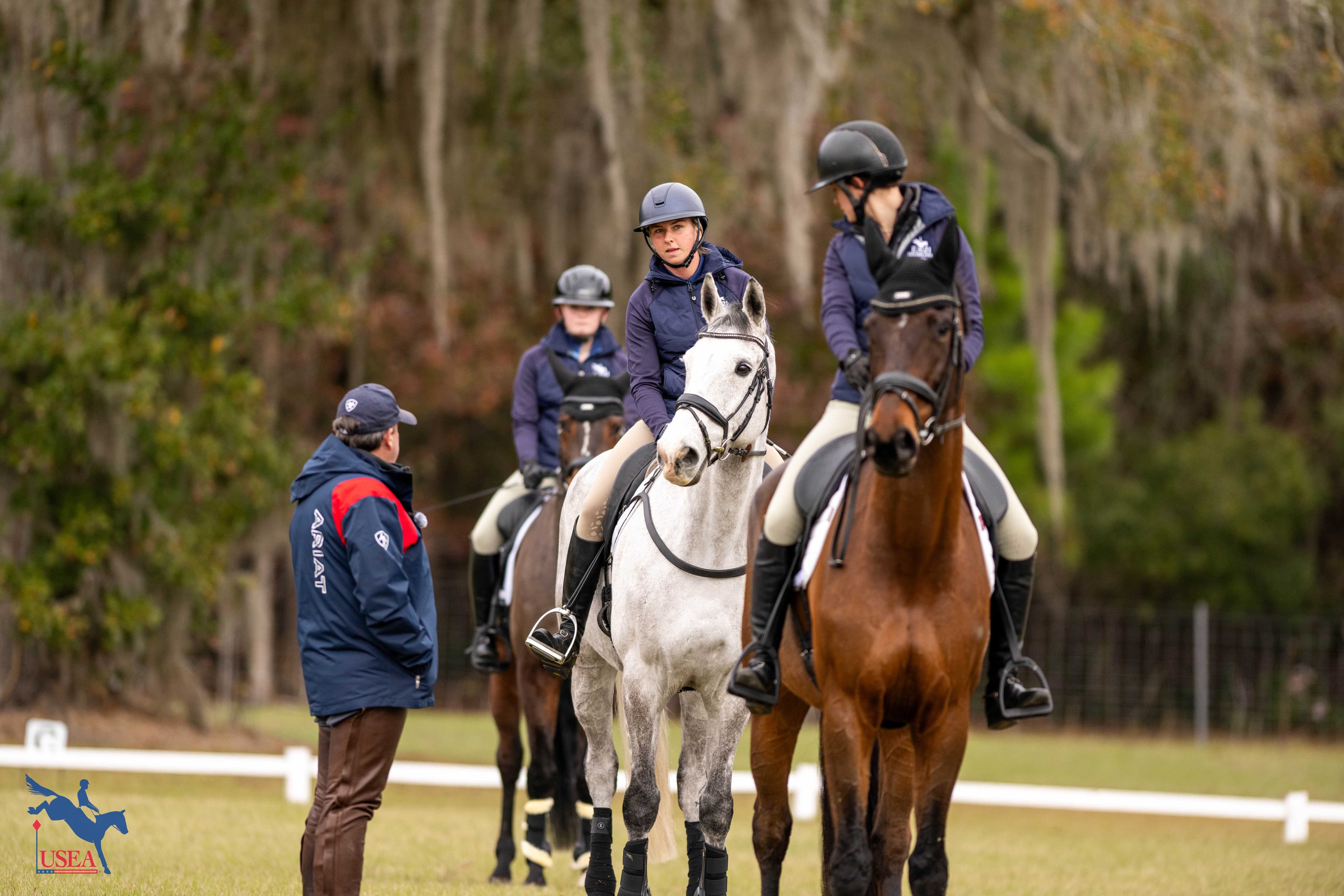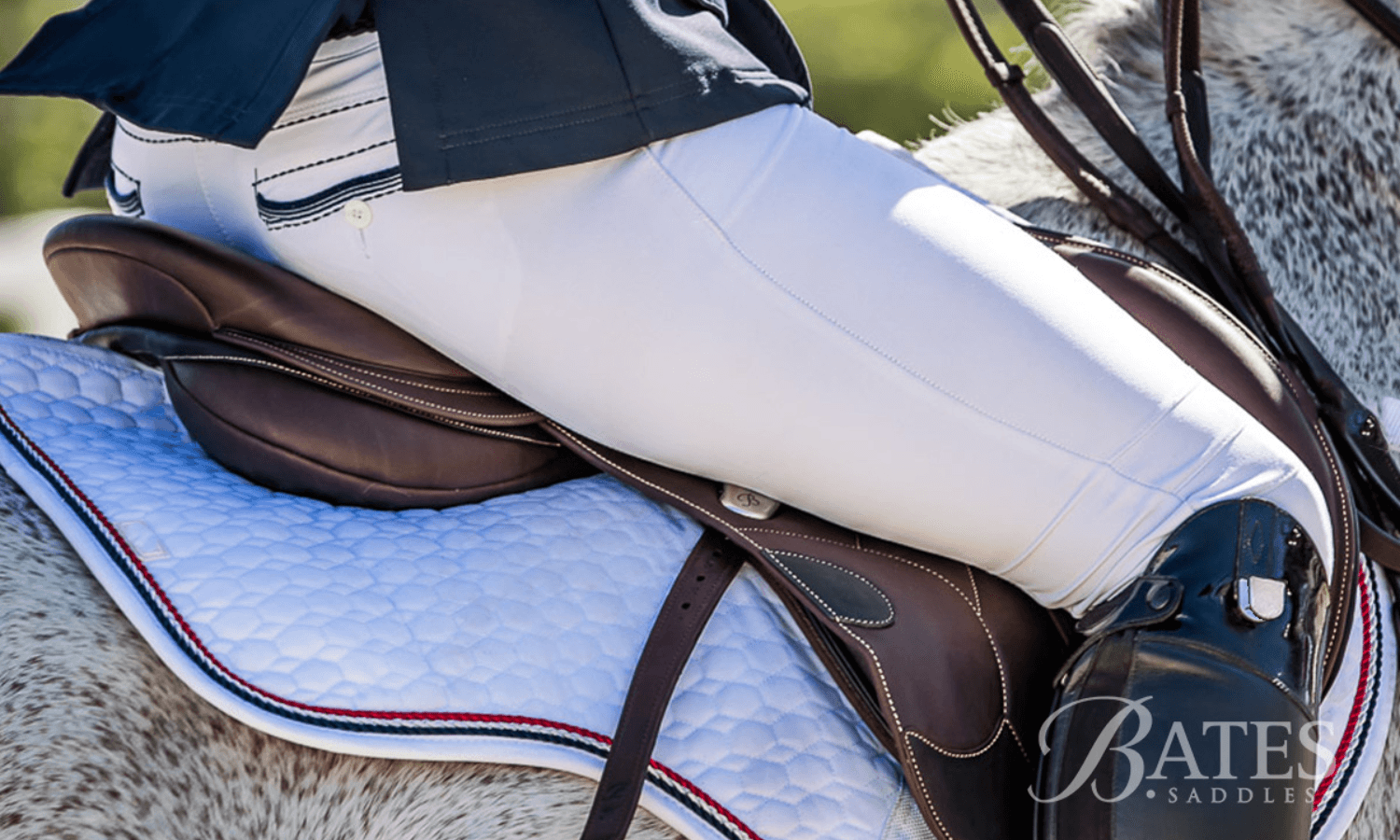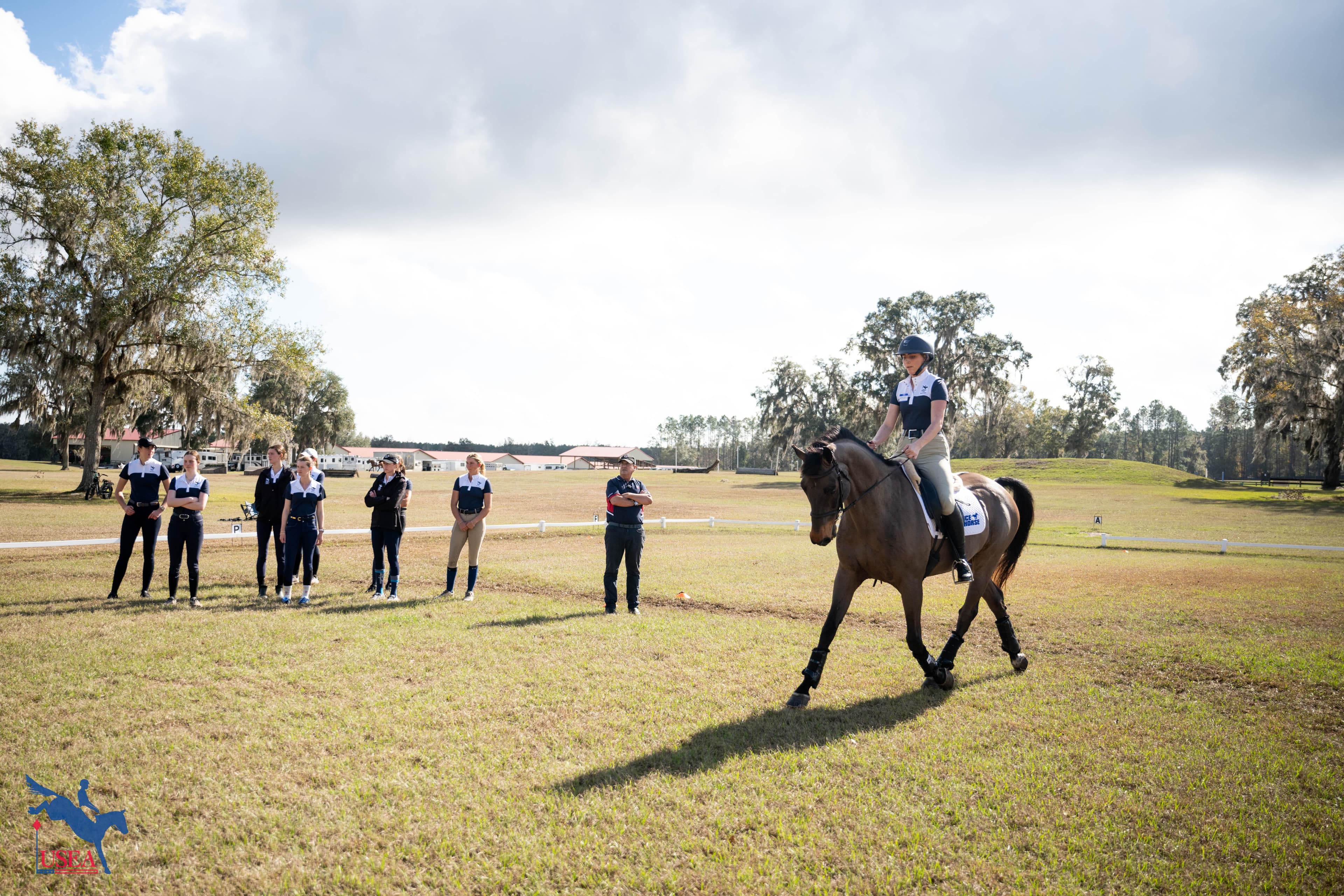Exploring Collapsible Technology for Cross-Country Jumps
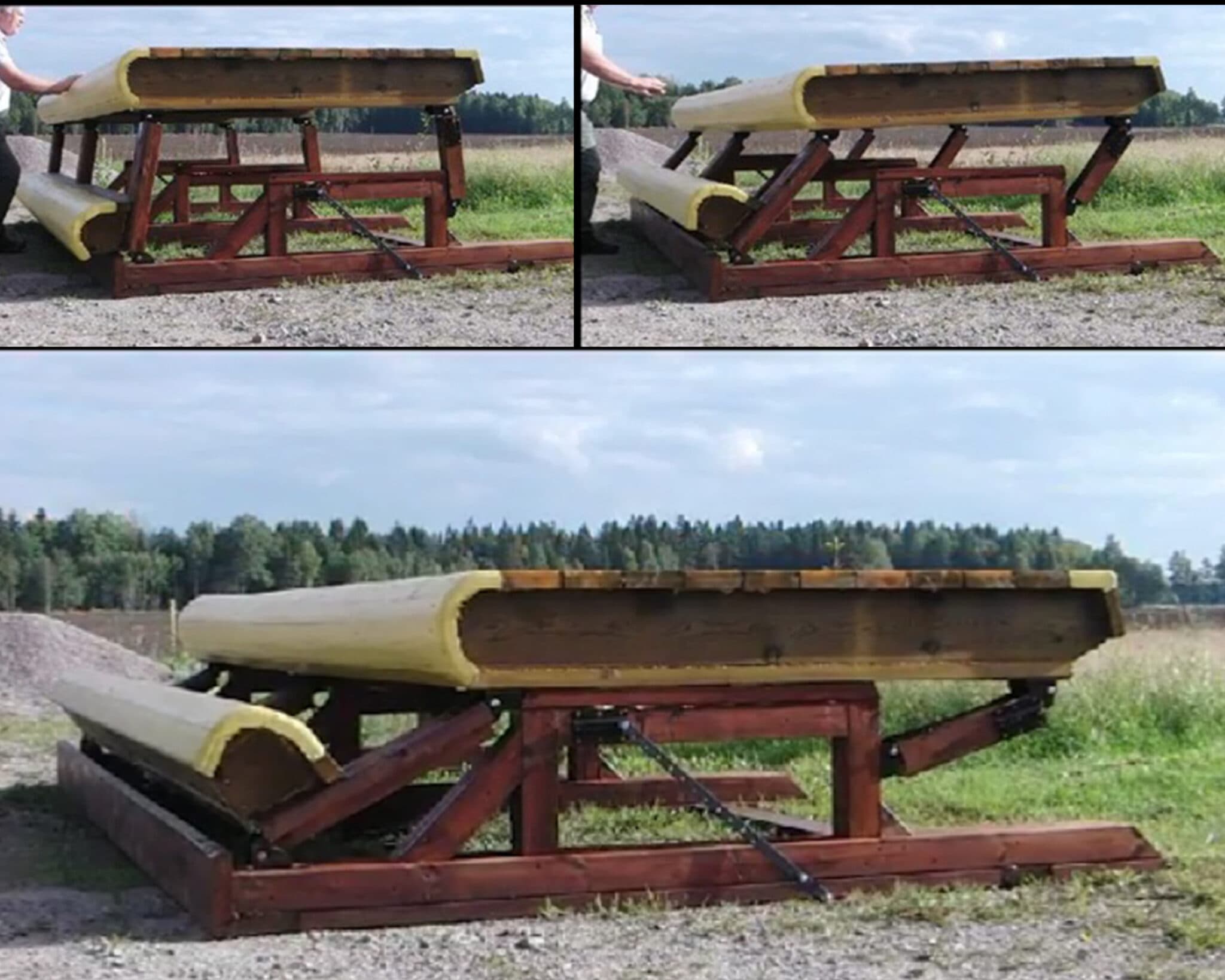
The USEA Cross-Country Design and Fence Construction Safety Task Force is a dedicated group consisting of officials, course designers, engineers, organizers and competitors. The goal of the group is to constantly evaluate all safety aspects of the cross-country phase of competition including, but not limited to, design and construction of the fences and courses. Overall, the main focus of the task force is to reduce the risk of both rider and horse injuries and fatalities while in competition. One of the key tools currently being used and further developed is collapsible (also known as deformable or frangible) technology. The United States Eventing Association (USEA), U.S. Equestrian (USEF), the Fédération Equestre Internationale (FEI) and other national associations and federations have been working to evaluate existing collapsible fence designs and to help and usher in the use of innovative and effective technologies.
Ultimately the goal of all parties is to reduce the number of rotational falls, and according to FEI data the use of deformable technology will not prevent falls, but it will reduce the risk of a somersault rotational fall.1
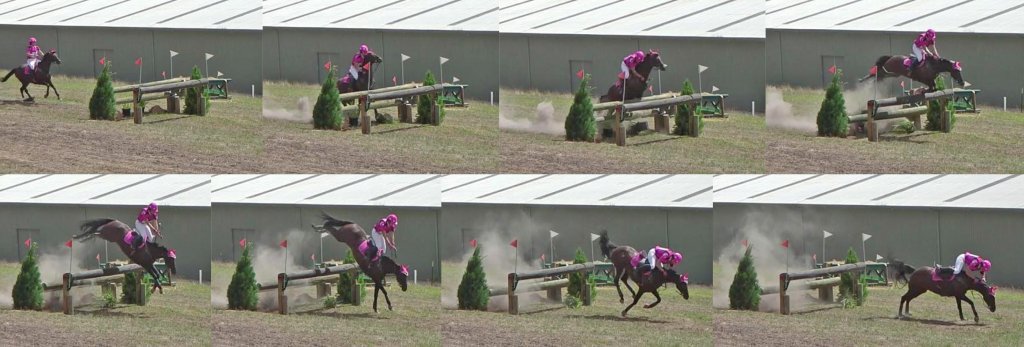
Rebecca McCrae and Hi Tide competing in the Tonimbuk CIC2*. Photos courtesy of rider.
In early March, Rebecca McCrae, a young rider from Australia activated a frangible device during the cross-country phase of the Tonimbuk CIC2*. “One mistake is all it takes for things to go pear shaped in our sport. At Tonimbuk H.T., partnered with a change in bit and lack of control I made one of these mistakes,” said McCrae on her Facebook page following the event. “I will happily admit that the new MiM Clips used by the course designer saved my life. Had these not been employed, I strongly believe that out of this situation I would be lucky to escape with my life. Big thank you to the committee for organizing these MiM Clips and course designer Ewen Kellet for ensuring their use.”
History of Deformable Technology in Eventing
Following a spate of eventing fatalities in 2001, the FEI commissioned the Transport Research Laboratory (TRL) in the U.K. to look into ways of reducing the risk of rotational falls. The 2001 study only tested vertical forces and not horizontal, leading to the production of the original forward facing British Eventing (BE) frangible pin. This meant that in order for the pin to break and the fence to deform, the horse had to be in a rotation already.
In 2009 research by Mats Björnetun and Anders Flogård of MiM Construction, world experts on crash prevention technology (e.g. crash dummies), showed that it is primarily the horizontal forces caused by the contact of the horse with the fence that results in a rotation. This discovery led to the development and introduction of the MiM system which releases instantly in response to horizontal forces.

The Mim Safe System releases instantly in response to a horizontal force.
MiM’s research prompted British Eventing to develop the reverse pinning system. It is now accepted that reverse deformable technology is the primary system that should be used rather than the traditional forward pinning. There are some very specific cases where front pinning may still be used. Instances like these are few and far between, but they do exist, such as the front rails of open corners.
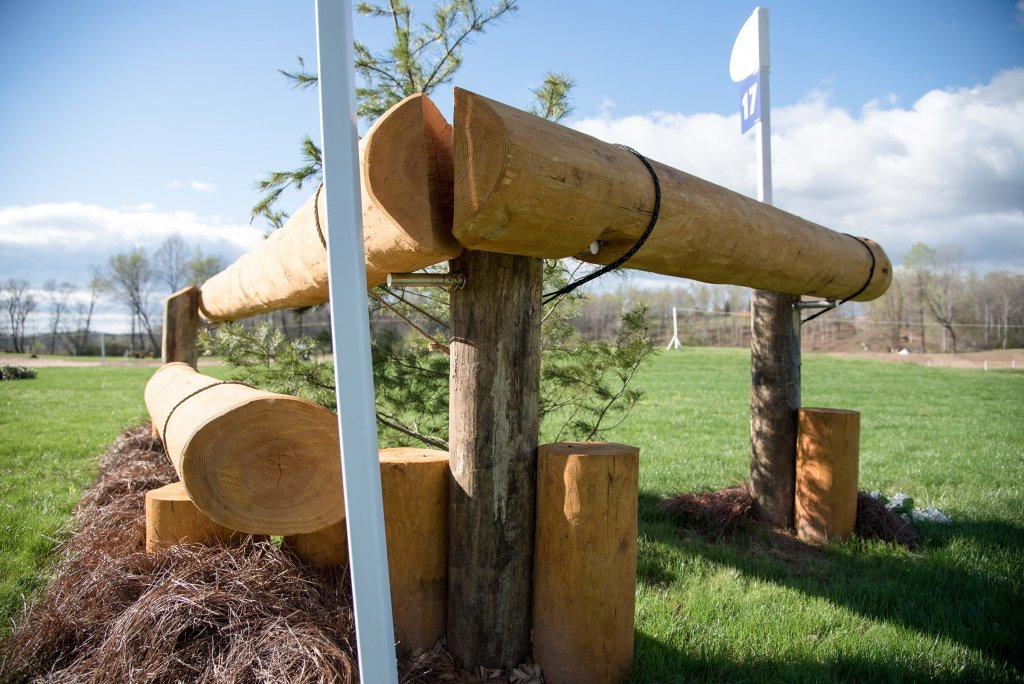
An example of an open corner which is both forward and reverse pinned.
In 2012, after much consultation, the FEI published a ‘standard’ that determined the force at which, if a horse hit a fixed fence, the device used would activate. This force was determined to be the minimum force the fence must be able to withstand before breaking, not a maximum. This was in an effort to create a level playing field for competitors. To date the only two approved safety devices are the MiM systems and the BE pins.
What is a rotational fall?
A rotational fall typically happens when a horse hits a fixed fence (usually on take-off) with sufficient vertical upward and horizontal force that it causes the horse to somersault. Once the horse has started to rotate the situation is irreversible and a rider has 0.9 seconds to respond. If the horse lands on the rider in a full rotational fall, it is likened to the effects of a 2 ton wall falling directly onto the rider, there is little chance of survival.
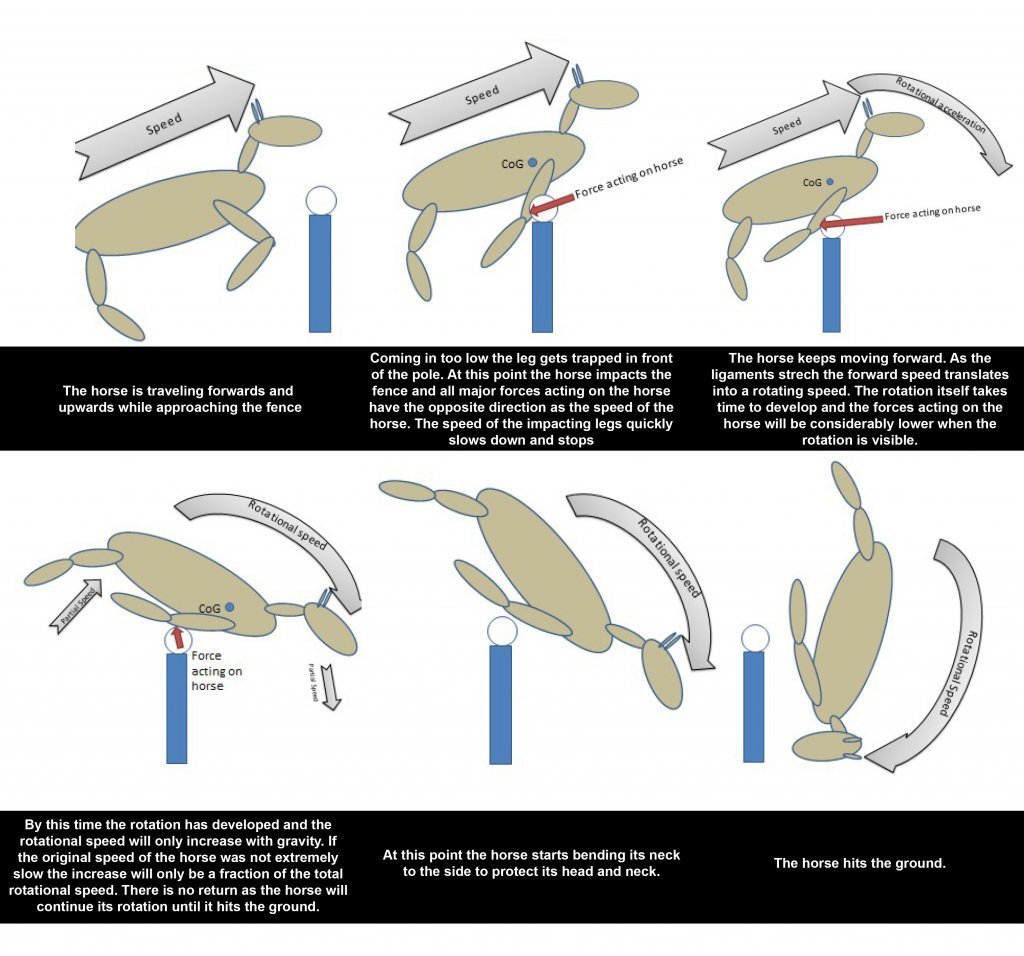
To stop horses rotating, the fence needs to absorb the impact. Some fences naturally absorb the impact of a horse hitting it, such as brush fences used in the racing world. Due to the construction of cross-country fences, it has become necessary to use deformable safety devices to reduce the risk of rotational falls occurring by reducing the force. Thus entered the idea of frangible fences.
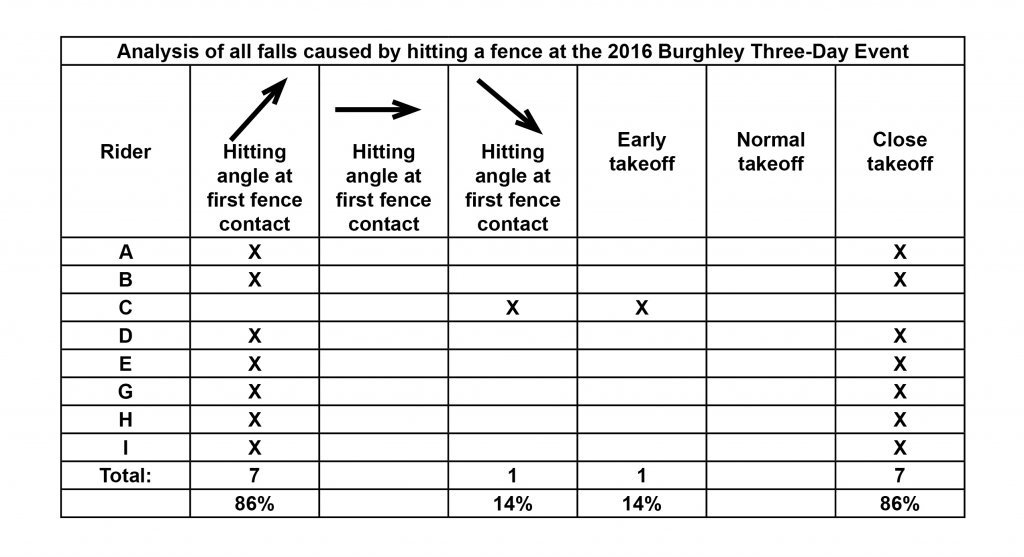
An analysis of falls at the 2016 Burghley CCI4* caused by horses hitting the fence was created by Anders Flogård of MiM.
Anatomy of the Jump
To understand the rotational fall we first need to understand how a jump works. A jump process includes four phases:
- Approach (this sets target speed and direction)
- Pitch up maneuver/takeoff
- Airborne segment
- Landing
A major aspect of a safe jump is that the approach to the jump encourages a good target speed and direction for successful crossing of the jump. This is achieved through proper course design by a certified and hopefully talented course designer. Beyond that, key factors are ensuring the takeoff point is such that the pitch up maneuver is completed in time and that the launch trajectory is well matched to the profile of the jump.
For purposes of this discussion, we assume the speed and direction are appropriate for the jump, and now consider what we can do to help the horse and rider accomplish a good takeoff point to launch from.
An important step in the jump process is the pitch up maneuver, which is the action of the horse lifting its front feet off the ground and placing the hind feet on the ground to push from and launch across the jump.
Initial video evaluation conducted by David Vos of a number of two-star and three-star riders traversing jumps on course indicate that the time taken to complete the pitch up maneuver is on the order of 180 milliseconds (0.18 seconds). The resulting distance covered while moving at the target speed is then the product of target speed and 0.18 seconds. For example, if the target speed is 600 meters per minute (10 meters per second) then the minimum distance between the takeoff point and the front of the jump is 10m/s x 0.18s, or 1.8 meters. This defines the closest take off distance from the obstacle that will prevent contact with the jump before completion of the pitch up maneuver. Placing ground lines to encourage takeoff from no closer than the minimum distance is intended to help reduce risk of the horse's front leg(s) making contact with the top/front of the jump.
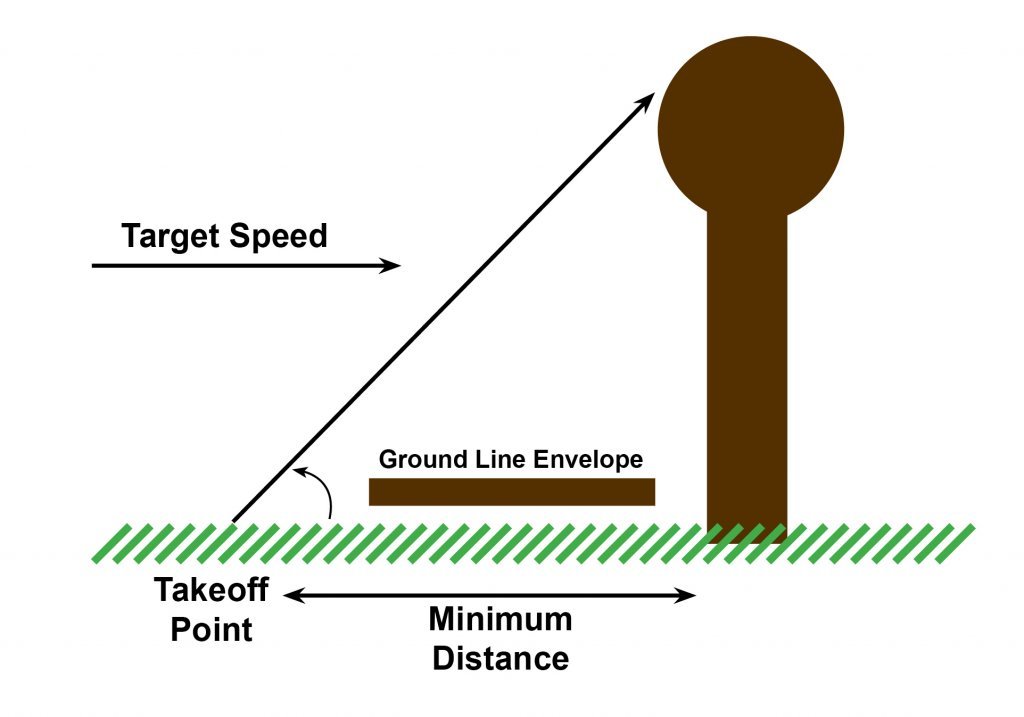
Distance needed to complete the pitch up maneuver ahead of a jump, when approaching the jump at the target speed. This defines the closest take off distance from obstacle that will prevent contact with the jump before completion of the pitch up maneuver. Placing ground lines to encourage takeoff from no closer than the minimum distance is intended to help reduce risk of the horse's front leg(s) making contact with the top/front of the jump.
What happens if there is a mistake and the takeoff point is too close to the jump?
If the horse and rider make a mistake and take off too close to the jump, given the approach speed and the point at which the pitch up maneuver starts (takeoff point), the horse does not have enough space to complete the pitch up maneuver, resulting in contact with the jump. An obvious way to help mitigate the severity of the resulting consequences is to make the jump able to be displaced upon contact such that it moves out of the way of the horse. Here again is why appropriate frangible technology is so vital to the sport.
Two key factors come into play in this case, namely:
- the mass of the displaced jump component and
- how well the displaced component of the jump gets out of the way.
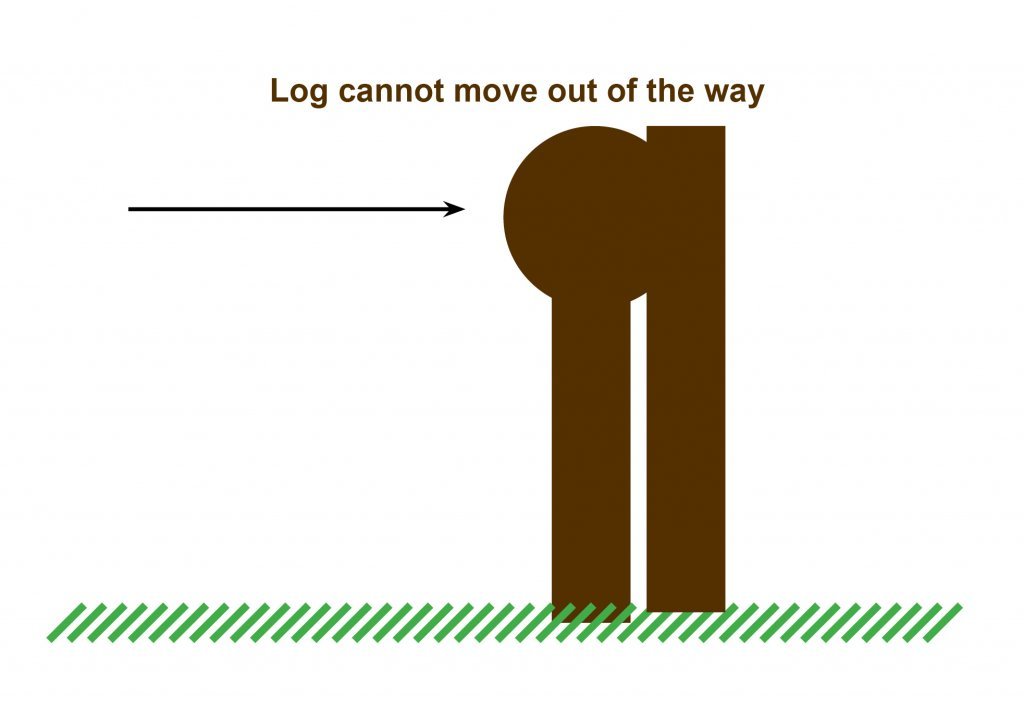
Obstacle design such that it is light enough and properly constrained to move out of the way upon severe enough impact. Note the improper mount of the third diagram: in this case, no matter how light or disengaged the log is from the jump, it is blocked from motion in the direction of the jump by the vertical back posts and cannot move out of the way.
A Deformable Table Jump
Table fences have long been understood as an intimidating obstacle for the rider. They have also been a common “portable” fence used for years.2 In the book The Photographic Guide to Jumping by Lesley Bayley and John Bowen3 the authors note that table fences are among those that “must be respected.” They continue on to say that table fences “need careful riding, albeit with a little more impulsion so that the spread is cleared.”
This combination of impulsion and care can be a difficult concept for many riders. Coupled with the imposing nature of the fences make them a difficult question. Test models for deformable table fences have been designed in the United States, Germany, Sweden, the U.K. and elsewhere.
In 2016 there were five fatalities in the sport of eventing around the world, and four of those were at “table” type fences not using deformable technology.
One example of a deformable table which has passed both FEI and BE testing is the MiM table. This deformable table concept illustrates that deformable jumps need not be limited to logs or vertical jumps.
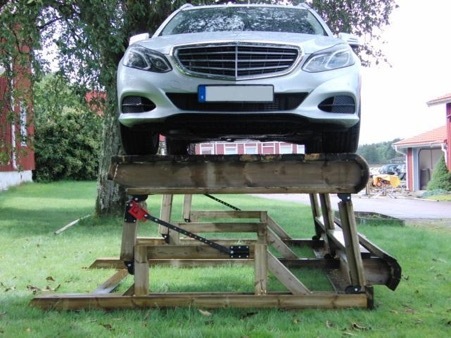
This is a Mercedes E-Class on top of the table. The weight of the car is 1710kg.
The table is strong enough to carry a horse as long as it does not try to stop on top of it and only uses it for banking. The horse would then only slide over it as the table would collapse forward and down. The force to activate the frangible devices in this case is above 500kg.
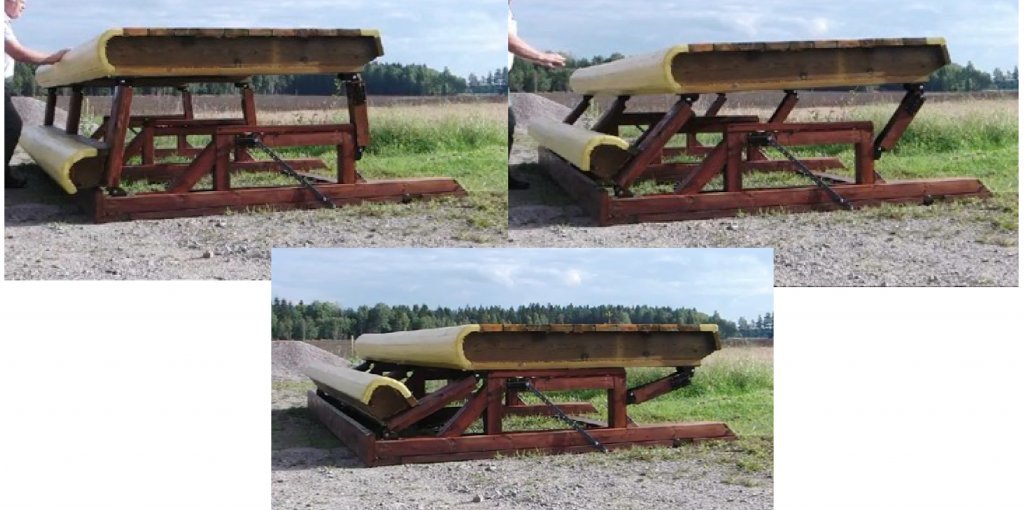
A demonstration of the MiM table.
The table is activated by a force driving it forward in the jumping direction. It then moves forward and down. The front is moving quicker down than the back of the table which moves down a little later. This difference can be seen in the three pictures above as a slight angle towards the front in the middle picture. This is to do to the fact that we need to make clearance between horse and fence as quick as possible.
The table’s back end is quite a distance from the ground when it all comes to a stop and there is not much chance to get caught under the fence. The horse has three options:
- Either it touches the fence hard enough to activate it, but still has a higher speed than the fence. It then clears the fence because of the high speed and won’t get caught under the rear end.
- It hits the fence hard enough to make the fence have a higher speed than the horse. It will then not reach the back of the fence before it is already down.
- A horse was to fall in a way that it got stuck directly on top of the table. This could potentially mean that the horse would be straddling the fence with its belly on the top and its hind legs in front while its front legs are over the back of the table.
While all three of these scenarios are not ideal in reality, they are no more dangerous than any other frangible fence currently in use.
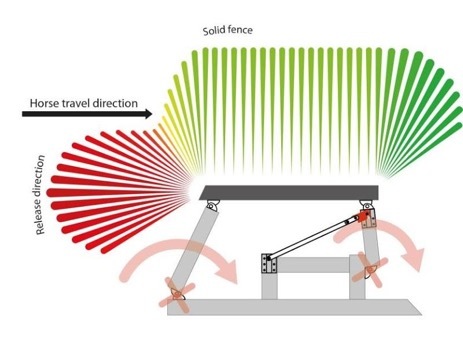
MiM clips on closed corners and tables
What is next?
Currently, the MiM system and the BE pin are the only two approved safety devices in use. We have described how these devices are currently being used. Research on rotational falls and deformable fences is being conducted around the world. In the U.S. this research is being funded through the USEA Foundation with financial support from concerned members of the eventing community. For more information visit www.useafoundation.org/projects.
Fortunately, safety in our sport is constantly evolving. We are confident that new ideas will continue to come forward from all around the globe. The end goal is that our sport can achieve an acceptable level of risk. While we must accept some risk in our beloved sport of eventing, the USEA will constantly be pushing to make things safer day by day and year by year.
- Fédération Equestre International (2012), Standard for the minimum strength of frangible/deformable cross country fences - Version 22, Page 2.
- Mary Gordon Watson, Hugh Thomas, Philip Herbert, Neil Ayer, Patrick Lynch, Richard Jeffery (1987) Course Design and Construction for Horse Trials – All Phases – All Levels, Page 46.
- Lesley Bayley, John Bowen (2005) The Photographic Guide to Jumping, Page 108.
About the Authors
Dr. David Vos
Dr. Vos is currently on a gap year! He led Project Wing at Google [X] through Nov 2016, culminating in the world's first month long drone delivery service at Va Tech. Prior to joining Google [X], Dr. Vos was Senior Director at Rockwell Collins after the acquisition of Athena Technologies – a leading flight control and navigation systems company – in April 2008. Vos was Founder, CTO and CEO of Athena Technologies. Having worked in the unmanned systems industry since its inception, he is a pioneer and a thought leader in the area of Unmanned Aerial Vehicles (UAVs). Born in South Africa and now a U.S. citizen, Vos is the inventor and developer of Rockwell Collins Control Technologies core technology. He holds patents in nonlinear control systems and other areas and has broad experience in guidance and control systems. From August 2007 thru 2014, Vos was appointed by Virginia’s Governor to Commissioner of the Vint Hill Economic Development Authority’s Board of Commissioners. In June of 2007, Vos was named by Ernst & Young as an Entrepreneur of the Year winner in the Greater Washington area. Vos holds a B.S. in Engineering with Honors in Aeronautical Engineering from the University of Stellenbosch, South Africa, an M.S. in Dynamics and Control from MIT, and a Ph.D. in Estimation and Control from MIT, in the Department of Aeronautics and Astronautics.
Andy Griffiths
In his younger years, Andy Griffiths rode in the European Championships and was long listed for the World Equestrian Games. After retiring from riding, he became an international Technical Delegate and Chair of the International Eventing Officials Club.

